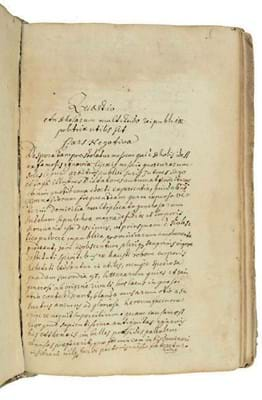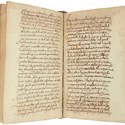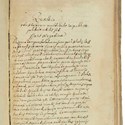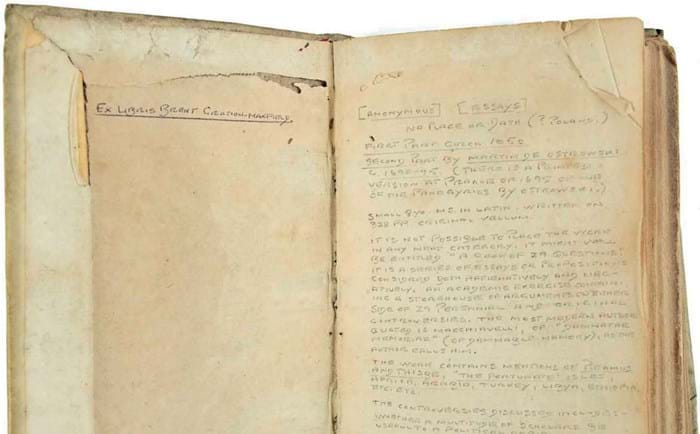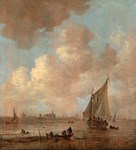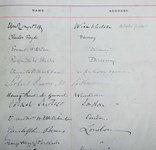One of the top prices in a Cornish auction this summer was for a small vellum-bound volume containing two long manuscripts in Latin dated to the 17th century.
They were offered at Lay’s (21% buyer’s commission) Rare Books & Works on Paper sale in Penzance on July 27.
The pencil notes and ownership inscription on the endpapers identified a previous owner as Brent Gration-Maxfield (1916-83), a bibliophile whose library was sold in various sales at Sotheby’s in 1969-71 and 1982, although this volume does not appear to have been offered in those sales.
Gration-Maxfield had identified the second part of the manuscript as being from the Panegyricus by Martin von Ostrowski which was first published in 1693.
The other manuscript in the first half of the volume does not have a title, which may explain why Gration-Maxfield had difficulty identifying the work.
One or two of the bidders appear to have cracked it, however, and identified it as being a manuscript of a philosophical work by the Hungarian Jesuit Gabriel Hevenesi (1656-1715) which was published in Vienna in 1690 with the title Philosophia sacra seu Quaestiones philosophicae occasione textuum S. Scripturae deductae, and illustrated with engraved allegorical emblems.
Estimated at £200-300, this volume, described by Lay’s as “a singular and intriguing work”, sold for £6900.
Insurance assurance

Upper cover of a fine Irish binding for the Rev Archdeacon Conway Benning, recording his membership of The Charter-Party, of the Amicable Annuity- Company of the Town of Newry, in the County of Downe, on August 1, 1700, which sold for £7200 at Lay's.
A fine Irish presentation binding was offered in the same sale, titled The Charter-Party, of the Amicable Annuity- Company of the Town of Newry, in the County of Downe, published in Dublin in 1770.
This small slim volume was finely bound in elaborately gilt tooled red morocco for the Rev Archdeacon Conway Benning with his name on the upper cover and the date August 1, 1700, which records the start of Benning’s membership.
Inside the volume are found the rules of membership and the signatures of the register and committee. This volume is an example of an early life insurance policy which remained very limited until the emergence of co-operative life insurance societies at the end of the 17th century.
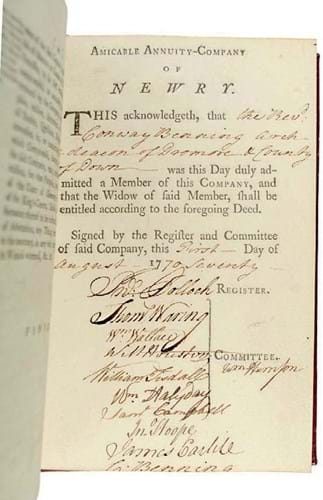
Page confirming the membership of the Rev Archdeacon Conway Benning to the Amicable Annuity-Company… with the signatures of the Register and Committee.
No copy of this work is recorded in the English Short Title Catalogue, and other examples printed in the 18th century for Limerick, Belfast and Dublin are recorded in only a handful of copies.
Estimated at £100-150, this volume sold for £7200.
Taken into British service
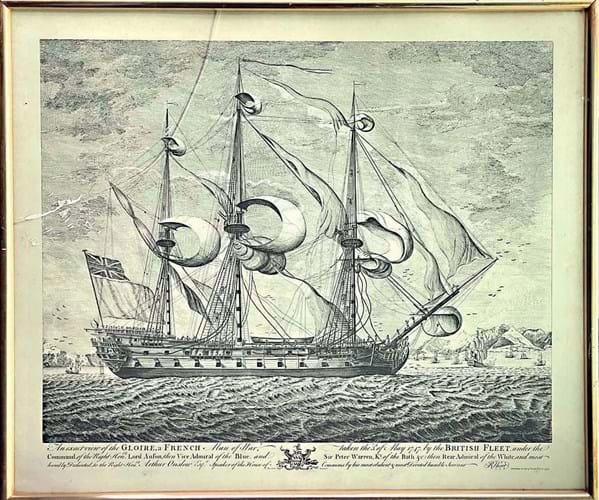
HMS Glory, formerly the French ship La Gloire which was captured by the British. One of a pair of engravings sold for £1250 at Lay's.
Cornwall is surrounded by the sea, so it may come as no surprise that a pair of 18th century prints of the ships Invincible and Glory proved popular enough in Penzance to sail above their £80-120 estimate and make £1250.
The two ships were originally French and launched as La Gloire and Invincible. They both served at the first Battle of Finisterre on May 14, 1747, during the War of the Austrian Succession, during which encounter the ships were captured and were taken into British service. At this defeat the French commander Saint-Georges handed his sword to Admiral George Anson.
Invincible was originally a 74-gun ship of the line of the French Navy and had been launched in October 1744; following her capture she served in the Royal Navy until wrecked in 1758 after hitting a sandbank in the East Solent between Langstone Harbour and the Isle of Wight. The wreck was rediscovered in 1979 and is now a protected site.
La Gloire was a 44-gun ship which after capture in 1747 served in the Royal Navy until sold to be broken up in 1763.
The engravings of these ships, which are now uncommon, were published by the most important British print publisher and retailer of the 18th century, John Boydell, in 1748 and 1750.



